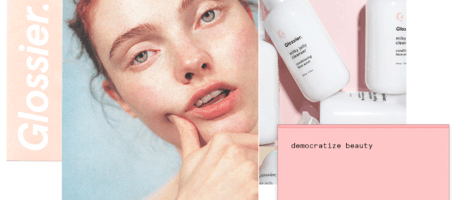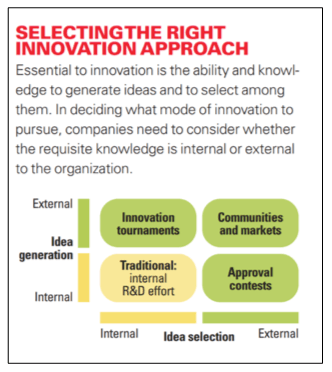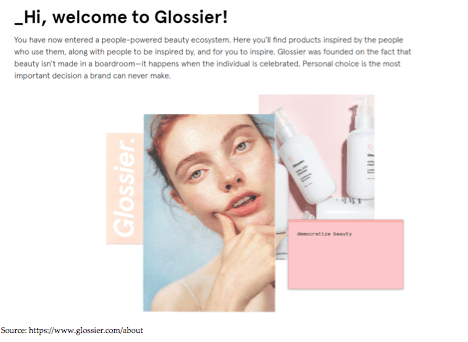Chez Glossier: How the Millennial Beauty Brand Built a Community Prime for Collaborative Innovation

On a mission to democratize beauty, cult makeup and skincare brand Glossier leverages their Into The Gloss blog, social media pages, and Glossier.com platforms to crowdsource product ideas from a community of highly loyal beauty lovers – yet maintains the final say.
Glossier is a direct-to-consumer beauty brand born out of beauty blog Into the Gloss, established in 2010, the brainchild of founder and millennial icon, Emily Weiss. The brand has created a beauty movement amongst millennial women and beyond, with a cult following of loyal users and brand evangelists, raising $86 million to date in funding since its launch in 2014.1
As a Glossier user, as well as a beauty industry professional, I can attest from my experience that the way Glossier has built their brand has other brands wondering what they can do to replicate a fraction of their brand loyalty, and consumers wondering how they can get even more access to the brand.
Much of Glossier’s massive success is attributable to their unique business philosophy, which Weiss has coined democratic beauty. “The point of Glossier is to democratize beauty… to give everyone a voice about the products we use,” she said. “And Glossier does that by having consistent, open conversation with our customers.”2
To achieve this goal credibly, open innovation through community collaboration is a critically important practice for the brand. As Boudreau and Lakhani note, collaborative communities are one of four ways to approach crowdsourcing, the others being contests, complementers, and labor markets (see table below for details).3

To successfully achieve the mission of democratic beauty requires not only a platform, but also a community of highly engaged users who unwaveringly trust the brand – not an easy feat in an age of skeptical, digitally-savvy consumers. In 2015, the brand crowdsourced ideas for their newest face wash through a blog post, asking, “What’s Your Dream Face Wash?”, receiving over 300 comments from their community4. In 2016, they repeated this strategy for a new moisturizer, this time eliciting over 1,000 comments – a testament to the high level of engagement within the growing Glossier community.5
Both a brilliant marketing tactic and innovation strategy, Glossier’s brand of open innovation could also be considered faux-pen innovation. As King and Lakhani discuss in their article, Using Open Innovation to Identify the Best Ideas, the most difficult management choice for successful open innovation is whether to open the idea generation process, idea selection process, or both.6
As the graphic below shows, the Into the Gloss community that Glossier leverages for innovation suggests external idea selection and generation. However, by maintaining internal residual control over both the scope of idea generation – dictating the choice of new product category (i.e. face wash) – and idea selection – final product attributes, ingredients, and package – Glossier maintains final control over both decisions. Through this strategy of quasi-open innovation, Glossier both creates a feeling of community inclusion and buy-in and ensures that the final product achieves its internal brand strategy.

In the short term, Glossier plans to continue this open innovation strategy with future product launches. Currently in development is a Glossier candle, announced a year ago with the blog post titled, “Help Us Develop the Glossier Candle”.7 In the medium term, Weiss has announced future plans to create a “social-selling website for beauty”, a fusion of social media and e-commerce through which Glossier will both sell its own products and “allow shoppers to get feedback from other users to find beauty products that are right for them”.8
As Glossier continues to grow, I would recommend a few additional steps the brand could take to address open innovation. First, to experiment with a community-sourced product launch extending true decision-making power externally to consumers in one or more dimensions (idea generation or selection). Secondly, in the interim before the “social-selling website” is launched, create an evergreen Glossier.com page to solicit ideas for both new products and improvement of existing products. This could help centralize insights that Glossier is already collecting from social media comments, blog comments, and their Facebook community group, Into The Gloss: The Group.9
Finally, the most critical piece of ensuring continued community engagement is to maintain trust. Glossier may want to consider communicating more transparently with customers about how comments and feedback from their Facebook group are used in product development. While the group is an effective way for Glossier to collect real-time information and draw insights from their 10,000 group members, if not proactively addressed, loyal consumers may start to feel wary of how much they choose to share on the platform.

While Glossier has undoubtedly been successful in leveraging their engaged community for product innovation and growing their following in the process, several questions remain: How can a community-based brand maintain trust as it grows beyond start-up size? How can a brand successfully balance authentically crowdsourced innovation with internal brand strategy? How can other brands build communities for innovation, in the absence of a proprietary blog?
(779 words)
Endnotes
1 Loizos, Connie. The Beauty Company Glossier Just Closed on a Whopping $52 Million in Fresh Funding.
February 2018. https://techcrunch.com/2018/02/22/the-beauty-company-glossier-just-closed-on-a-whopping-52-million-in-fresh-funding/
2 Siegel, Emily. Emily Weiss on Glossier and Into the Gloss in 2015. 5 May 2015. https://www.forbes.com/sites/emilysiegel/2015/05/05/emily-weiss-glossier/#772b36937a42
3 Boudreau, Kevin J., and Karim R. Lakhani. Using the Crowd as an Innovation Partner. Harvard Business Review, vol. 91, no. 4, Apr. 2013, pp. 60–69. EBSCOhost, ezp-prod1.hul.harvard.edu/login?url=http://search.ebscohost.com/login.aspx?direct=true&db=bth&AN=86173288&site=ehost-live&scope=site.
4 Weiss, Emily. The Glossier Cleanser: What’s Your Dream Face Wash? 2014. https://intothegloss.com/2015/01/emily-weiss-glossier-cleanser/
5 What’s Your Perfect Heavy-Duty Moisturizer? 2015. https://intothegloss.com/2016/02/glossier-heavy-moisturizer/
6 King, A., & Lakhani, K. R. (2013). Using open innovation to identify the best ideas. MIT Sloan Management Review, 55(1), 41-48. Retrieved from http://search.proquest.com.ezp-prod1.hul.harvard.edu/docview/1438826527?accountid=11311
7 Souto, Melissa. Help Us Develop the Glossier Candle. 2017. https://intothegloss.com/2017/08/glossier-candle/
8 Bhasin, Kim and Janine Wolf. Inside Glossier’s Plans to Shake Up Your Makeup Routine. 30 August 2018. https://www.bloomberg.com/news/features/2018-08-30/millennial-makeup-brand-glossier-shakeup-makeup-routine
9 Into the Gloss: The Group. https://www.facebook.com/groups/1698970133500106/




It seems to me that Glossier does a good job of balancing crowd sourced ideas with brand strategy by limiting the scope and authority of customer’s inputs. I would like to know exactly how much weight is given to the user’s opinions when developing a product and if Glossier uses it primarily to confirm something they already had planned or actually use the customer’s ideas to innovate. Regardless, it is a genius way to make people feel like they have an voice in the company’s product lines, whether they do or not.
Totally agree! It’s absolutely genius, and I have the same questions… would love to get a better sense of how consumer input is used. Either way, as a consumer hearing about it for the first time I was impressed and excited with the potential impact I could have.
Super interesting, and of course they’ve been really successful with this. In response to your second question – I think that the customer opinion kind of IS their brand strategy, no? If enough people ask for a wacky product, you know it will probably do well in terms of sales, even if it’s “off brand” from what you originally intended Glossier to be. I think it’s all mold-able enough within their product packaging and marketing scheme that if something really strange was suggested, well it would probably still work!
I would be inclined to take an even harsher stance on Glossier’s approach to open innovation. It seems that Glossier is promoting the false promise of democratization of beauty – they are providing a forum through which they can ‘listen’ to their customers, but there is no indication that they are actioning or incorporating their recommendations. Listening to your customer is not a new phenomenon, nor is it a unique business practice or aspect of the beauty industry. As you mention above, Glossier maintains control over both the scope of idea generation and idea selection. This sounds less like an example of open innovation and more of a strategy to engage consumers. I agree with your recommendation, that if Glossier is truly committed to the ‘democratization’ of beauty they need to extend true decision making-power to consumers.
I really enjoyed your overview of how Glossier is using open innovation. I particularly liked your use of the term “quasi-open innovation.” I think you could even go further with that comment and argue that this is “quasi-open product development” more so than “innovation” since some of the products are not necessarily breaking new ground.
As to your question about other brands building communities for innovation: I know many direct-to-consumer brands use customer service as not only a way to solve customer problems but also an opportunity to collect information. Emails and phone calls can be tagged in such a way to keep track of what the most requested new products are. This seems like one potential avenue to achieve what you asked about.
I loved reading this article, as I had never heard of open innovation being used in the beauty industry!
The main risk I see to a community-based brand is losing its credibility as it grows – as you also indicated in your closing questions. As a parallel, consider famous bloggers/vloggers. The vast majority of them earns a living of their brand endorsements. However, as their accounts grow, so does skepticism on the sincerity of their endorsements (further exacerbated by governments forcing famous bloggers/vloggers to explicitly state #ad whenever a post is sponsored). For Glossier, as the amounts of comments on their platform grows, how can we trust they actually invest in the capacity to take all input into account? And is that investment even realistically feasible?
This is a very innovative way for Glossier to generate new ideas and figure out exactly what is being demanded from their consumer base directly!
In your article you discuss four ways to crowd source problem solving. One of the examples you provide is the use of contests to spark innovation and community input. It seems that this is an avenue that Glossier has not yet pursued and could be an interesting way to keep users engaged as the brand continues to grow. One concern would be that contests could potentially discourage continued input from the Into the Gloss community, but I would be interested to hear your take on the idea. This could potentially be a strategy for other beauty brands that have not yet built up the same collaborative platforms as Glossier.
Having raised $86 million, the likely outcome for Glossier is an IPO or selling to a cosmetics conglomerate. History has shown that the result of such a liquidity event often leaves a company’s engaged audience feeling ostracized.
One way to avoid having its fans feeling like the company “sold-out” after liquidity is to also share the corporate journey. Not only will the consumers feel involved in helping with products, but they would likely remain loyalists if the founder shared her long-term vision and blogged about reaching each milestone.
In 1997, Amazon founder Jeff Bezos famously wrote his first letter to shareholders that stated, “We will continue to focus relentlessly on our customers.” The founder has remained true to his word, which is why Amazon is one of the few companies in the U.S. that is equally beloved by consumers and Wall Street.
Thanks for posting on this interesting topic.
In my opinion, this is as much as a marketing process than an open innovation one as mentioned in your post. In this day and age, all beauty brand try to create a community and to engage a conversation with them. One of the other major beauty success of the last years was Kylie Jenner and her make-up brand Kylie cosmetics. The reason for this success was her massive following and loyal community on social media.
Glossier has created a community and I feel that their open innovation process is just a way to interact with them, make them a part of the process. I am not sure that their product are superior to the competition but do they need to?
After all it is simpler to sell to your loyal customers what they ask you for …
I too am a huge fan of Glossier; however, I find their significant growth to be concerning. Glossier has been able to capitalize on our generation’s preferences “to be heard” through both the crowdsourcing you describe and through their impeccable customer service that aims to go above and beyond the industry standard. However, this has been in a time in which Glossier is funded by VC’s (e.g., Forerunner) that are comfortable with a company generating zero to minimal profits. As the company continues to scale and mature in investment stage, I foresee larger (and less patient) investors demanding Glossier begin to prioritize different metrics (e.g., increasing labor efficiency, increasing physical distribution) and it concerns me that the company will lose the very value proposition with which they have found success. I also wonder what Emily Weiss’s role will continue to be moving forward and whether the business can sustain a potential future departure.
You ask: “How can a community-based brand maintain trust as it grows beyond start-up size?” I think a helpful approach may be to open retail stores throughout the country. This gives customers an opportunity to give feedback and share ideas with the company in person (rather than over-sharing online), and it also has a host of positive effects for Glossier, including free advertising, new customers, etc.
I also take quite a cynical view on this. I think this is really mostly a marketing strategy rather than genuine open innovation. The quasi-open innovation used by Glossier (chosen product category, opaque process of final decision making) doesn’t seem so different from management occasionally reading product reviews by its customers, in terms of how much customer feedback gets incorporated. But the way Glossier does it is obviously quite smart in getting a new round of attention from its loyal customers. Another concern I have with the cult-like nature of the Glossier community – the loyalists are so loyal, that I don’t think any skeptics will voice their opinions. They are likely just going to leave. This self-selecting nature also partially invalidates the open innovation idea.
Beauty industry insiders all know how easy it is to formulate and make a product. Some have even said openly how much gross margin there is, and how easy it is to create a new brand and line of products (Hello, Kylie Cosmetics) and pocket huge financial gains. If Glossier truly wants to differentiate by using open innovation, it should open up its product development process much more. Until then, this cynic won’t convert!